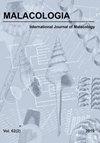Burnupia ingae Lanzer, 1991(腹足目:亲水目):对其形态和首次记录的贡献
IF 0.7
4区 生物学
Q4 ZOOLOGY
引用次数: 1
摘要
Burnupia Walker, 1912年,是淡水帽贝的一个属,传统上被认为属于帽贝科(Pilsbry & Bequaert, 1927;Hubendick, 1964;布朗,1994;Lanzer, 1996;Hodgson & Healy, 1998),或被纳入Planorboidea超家族中的Ancylini部落(Bouchet & Rocroi, 2005)。然而,其分类地位存在争议:基于radula形态学的相似性,Pilsbry(1920)提出Burnupia与南美洲Uncancylus Pilsbry(1913)关系密切。Brown(1965)将该属归入Ferrissiidae科,而Burch(1962)根据单倍体染色体编号17,提出Burnupia与la蒸发虫之间的密切关系,形成la蒸发虫亚科。Albrecht et al.(2004)测试了Burnupia的壳形是否独立进化,并推断了它在Basommatophora中的位置。他们的结论是,像Hubendick(1978)之前提出的那样,在Basommatophora中,髌状壳的形状至少进化了三次,代表了趋同进化的情况。目前,根据Albrecht等人(2007)的说法,Burnupia被认为是在Ancylinae之外,他们提出了这个属的一个新的“未命名分支”。Burnupia不仅与Ancylinae不同,而且与Planorboidea超家族的所有其他代表都不同(Albrecht et al., 2007)。关于burupia的分布,它一直被认为是非洲的地方性疾病(Basch, 1963;赖特,1963;Hubendick, 1964;Albrecht et al., 2004),范围从埃塞俄比亚和东非的高地,向南进入扎伊尔、安哥拉和津巴布韦,并广泛分布于南非(Walker, 1924;Hubendick, 1964)。昆虫学报,2016,59(2):333−339本文章由计算机程序翻译,如有差异,请以英文原文为准。
Burnupia ingae Lanzer, 1991 (Gastropoda: Hygrophila): Contributions to the Knowledge on Its Morphology and First Records in Rio De Janeiro State, Brazil
Burnupia Walker, 1912, is a genus of freshwater limpet traditionally considered as belonging to the Ancylidae (Pilsbry & Bequaert, 1927; Hubendick, 1964; Brown, 1994; Lanzer, 1996; Hodgson & Healy, 1998), or included in the tribe Ancylini in the superfamily Planorboidea (Bouchet & Rocroi, 2005). However, its taxonomic position is controversial: based on similarity of radula morphology Pilsbry (1920) suggested a close relationship between Burnupia and South American Uncancylus Pilsbry, 1913. Brown (1965) placed this genus into the family Ferrissiidae, whereas Burch (1962) proposed a close relationship between Burnupia and Laevapex forming the subfamily Laevapecinae on the basis of the haploid chromosome number 17. Albrecht et al. (2004) tested whether the shell shape of Burnupia evolved independently and inferred its position within the Basommatophora. They concluded that the patelliform shell shape evolved at least three times in the Basommatophora, as previously proposed by Hubendick (1978), representing cases of convergent evolution. Currently, Burnupia is considered outside the Ancylinae according to Albrecht et al. (2007), who suggested a new “unnamed clade” for this genus. Burnupia not only appears to be distinct from the Ancylinae but also from all other representatives of the superfamily Planorboidea (Albrecht et al., 2007). In reference to the distribution of Burnupia, it has long been considered endemic to Africa (Basch, 1963; Wright, 1963; Hubendick, 1964; Albrecht et al., 2004), ranging from the highlands of Ethiopia and East Africa, southwards into Zaire, Angola and Zimbabwe, and widespread in South Africa (Walker, 1924; Hubendick, 1964). Subfossil MALACOLOGIA, 2016, 59(2): 333−339
求助全文
通过发布文献求助,成功后即可免费获取论文全文。
去求助
来源期刊

Malacologia
生物-动物学
CiteScore
2.00
自引率
0.00%
发文量
15
审稿时长
3 months
期刊介绍:
Malacologia publishes papers on all groups of the Mollusca. Malacologia specializes in publishing long papers and monographic treatments. Complete data are especially appreciated. Papers must be of interest to an international readership. Papers in systematics, ecology, population ecology, genetics, molecular genetics, evolution and phylogenetic treatments are especially welcomed. Also welcomed are letters to the editor involving papers published or issues of import to science of the day.
 求助内容:
求助内容: 应助结果提醒方式:
应助结果提醒方式:


